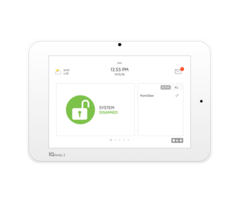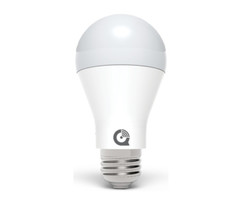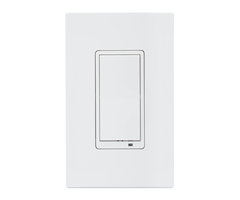After our big return last week, we're back in a major way with 12 new videos this week! As our headquarters has only partially reopened, I had to try doing some videos again. But a familiar face has returned. We're sure you're eager to see who. Anyway, here come the new Alarm Grid videos!

Adjusting Z-Wave Device Limits On My Qolsys IQ Panel 2 Plus
I show you how to adjust the Z-Wave device limits on your Qolsys IQ Panel 2 Plus Security System. The Z-Wave device limits determine how many of each Z-Wave device type you can pair with the system. There are limits for thermostats, smart sockets, door locks, lights, garage doors, and "other" Z-Wave devices. The maximum total limit for all devices combined is 152 Z-Wave devices. You will need the Installer Code or Dealer Code (default 1111 and 2222, respectively) to change these limits. Also note that the Z-Wave device limit for Alarm.com is 122 Z-Wave devices.
Upgrading the Z-Wave Firmware for My Qolsys IQ Panel 2 Plus?
I show you how to upgrade the Z-Wave firmware for a Qolsys IQ Panel 2 Plus System. This is something you may want to do if the system is running a Z-Wave firmware of less than 6.81.03. At that Z-Wave firmware, you unlock the Smart Start feature for quickly adding Z-Wave devices, and you upgrade the system to the S2 security protocol for automation devices. Any Qolsys IQ Panel 2 manufactured with System Firmware Version 2.4.0 or higher (upgrading later doesn't count) will already have this Z-Wave Firmware Version.
Overview of the Smart Start Feature on the Qolsys IQ Panel 2 Plus
I talk about the Smart Start feature that can be used with any Qolsys IQ Panel 2 that is running Z-Wave Firmware Version 6.81.03 or higher. The Smart Start feature allows you to pair Z-Wave devices by scanning a QR code, instead of performing a traditional inclusion/exclusion process. As of June 2020, only a very limited selection of Z-Wave devices from Qolsys, Alarm.com, Eaton, and Danalock are compatible with the feature. But it can save you time if adding a large number of Z-Wave devices.
Using the Smart Start Feature on the Qolsys IQ Panel 2 Plus
I show you how to use the Smart Start feature on a Qolsys IQ Panel 2 Plus to add new Z-Wave devices. If your IQ Panel 2 is on Z-Wave Firmware Version 6.81.03 or higher and you have a compatible Z-Wave device, then you can use the Smart Start feature to add it to the Z-Wave network. Depending on the Z-Wave device, the QR code may be on the packaging or on the device itself. Some may have the code on both the packaging and the device.
How Many Z-Wave Devices are Supported on the 2GIG GC2 or GC2e?
I discuss the Z-Wave device limits for the 2GIG GC2 and the 2GIG GC2e. The classic GC2 has a standard Z-Wave controller, while the newer GC2e has an upgraded Z-Wave Plus controller. Both support the same Z-Wave devices, though Z-Wave Plus devices will get an extended range and battery life when used with the GC2e. The Z-Wave device limit for both systems is 232 Z-Wave devices, though it should be considered that adding a very large number of Z-Wave devices can diminish system performance.
How Many Z-Wave Devices are Supported on the 2GIG GC3 or GC3e?
I discuss the Z-Wave device limits for the 2GIG GC3 and 2GIG GC3e. Both of these systems have built-in Z-Wave Plus controllers for building an automation network of smart devices. Just like the "lower-end" 2GIG Systems, the GC3 and GC3e can support a maximum of 232 Z-Wave devices, though usually far fewer are actually used in practice. You should also keep in mind that Alarm.com has its own Z-Wave device limit of 122 devices. This means that only the first 122 Z-Wave devices paired with the system will get pushed over to Alarm.com.
Excluding the Kwikset Z-Wave Lock from the Lyric Controller
I show you how to exclude a Kwikset Z-Wave Lock from a Z-Wave network using a Honeywell Lyric Alarm System. Clearing the lock from the network will wipe out all of its residual Z-Wave data. This is normally done before adding the lock to the Z-Wave network, or when you need to delete it from the system. The Lyric can be used to clear the Z-Wave network data in the lock, even if the lock wasn’t paired using the Lyric to begin with.
Including the Kwikset Z-Wave Lock from the Lyric Controller
I show you how to pair a Kwikset Z-Wave Lock with your Honeywell Lyric Alarm System. This will allow you to control the lock from the panel and remotely from Total Connect 2.0 if the system is monitored and set up with the service. Normally, an exclusion process is performed before the inclusion process. Most Kwikset Locks have a simple button that is used for including and excluding. Pressing this button while the system is in its inclusion mode will include the lock into the Z-Wave network.
Excluding a Schlage Z-Wave Lock with the Honeywell Lyric
I show you how to exclude a Schlage Z-Wave Lock from a Z-Wave network using the Honeywell Lyric Alarm System. Just like most other Z-Wave devices, an exclusion process is normally performed either before adding the device to the Z-Wave network, or when deleting the device from the Z-Wave hub. For a Schlage Lock, you must access the programming code that is found on a white sticker underneath the lock's main cover. You will need a screwdriver to remove this cover.
Including a Schalge Z-Wave Lock with the Honeywell Lyric
I show you how to include a Schlage Z-Wave Lock to the Lyric's Z-Wave network. A Schlage Lock will follow the same process for inclusion as it does for exclusion. However, you will normally want to exclude the lock first to wipe out any residual Z-Wave data. To include the lock, simply enter the programming code on the lock's sticker, followed by the [0] key while the Lyric System is in the appropriate Z-Wave inclusion mode.
Enrolling a Z-Wave Lock to My Qolsys IQ Panel 2
In his triumphant return, the always fantastic Jorge shows you how to enroll a Z-Wave door lock to your Qolsys IQ Panel 2 System. This is done by putting the IQ Panel 2 into its Z-Wave inclusion mode and then activating the inclusion function on the lock. For most locks, you will want to clear the lock from the network to wipe its residual Z-Wave data before completing the inclusion process. The lock can then be controlled from the panel, as well as from Alarm.com if the system is monitored with access to the service.
Resetting an Interlogix Simon XT to Factory Defaults
This is an update from a previous video shot more than a year ago. Jorge shows you how to reset an Interlogix Simon XT System back to its factory default settings. This will reset the Master Code (1234) and the Installer and Dealer Codes (both 4321), delete any added codes and system zones, and restore all settings and configurations to their default values. It is important to note that if the option for "Phone Lock" in system programming is enabled, then certain settings will not be affected by the default.
















